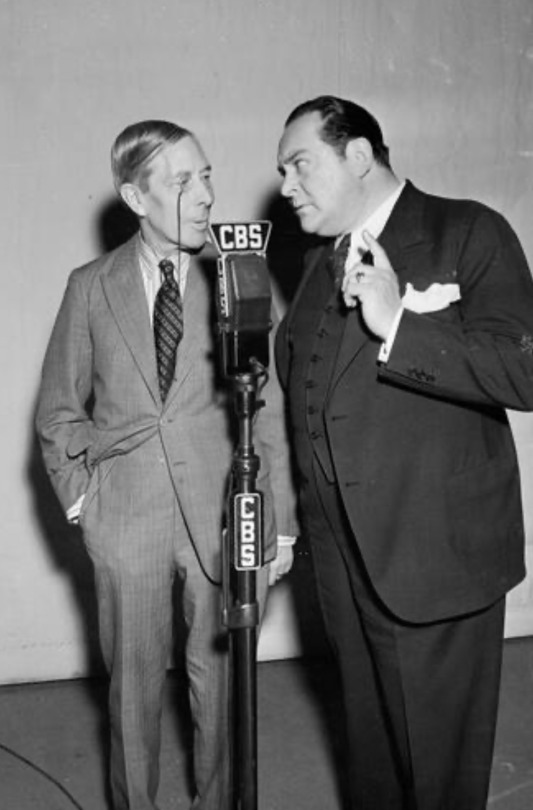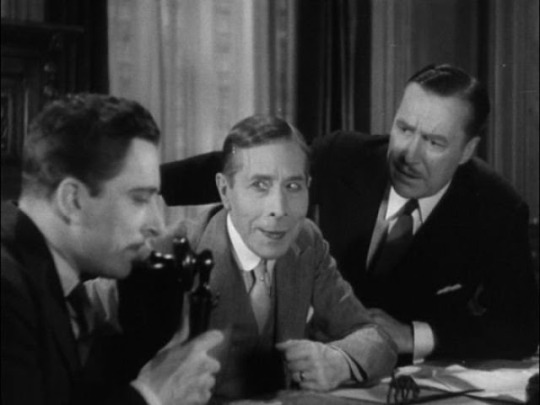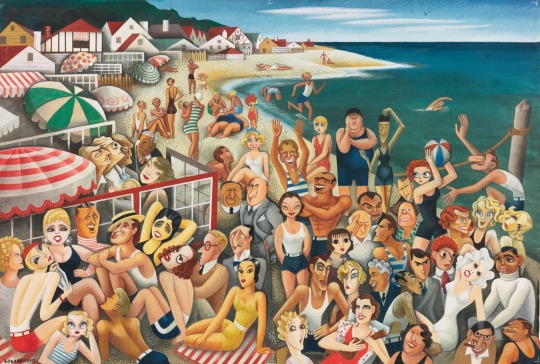#George Arliss
Text

George Arliss with Edward Arnold at the CBS microphone for a 1938 radio performance of 'Disraeli'.
22 notes
·
View notes
Text

HOLLYWOOD REPORTER, February 14, 1933
#vintage advertising#vintage advertisement#1930s#movie ad#warner bros#james cagney#barbara stanwyck#george arliss#ruth chatterton#george brent#1933#pre code
23 notes
·
View notes
Text

April 1935. Seeing people refer to Cardinal Richelieu as "the Catholic Darth Vader" (which seems entirely apt) brought to mind this 1935 movie with George Arliss. Largely forgotten today, Arliss was one of the most respected actors of his era, having had a lengthy career on stage and in silents before making his first talkie in 1929. Most of his talkie vehicles feature him as a cagy old Tory reprobate triumphing over his opponents through a combination of guile and charm, usually while also showing his support for #girlbossing by arranging an appropriate match for a young female protege — "appropriate match" in most cases meaning "a stalwart, none-too-bright young man of good prospects who can be made to do whatever she says." This is precisely the formula for CARDINAL RICHELIEU, which is based (loosely) on an old Edward Bulwer-Lytton play: Richelieu protects his protege (Maureen O'Sullivan) from the unwelcome attentions of the king (Edward Arnold), finds her a good (dumb) husband (Cesar Romero in one of his earliest featured roles), and saves France with his cunning stratagems. He's even a cat person, and his cat, Mistigris, features in a lot of the posters and promo images.
Arliss later reprised his role in CARDINAL RICHELIEU on THE LUX RADIO THEATRE in January 1939, reuniting most of the film cast. I think that might actually have been his final public performance; he was in his 70s by then, and his last movie role (in DR. SYN) had been in 1937.
CARDINAL RICHELIEU has nothing directly to do with THE THREE MUSKETEERS, but it should be mandatory viewing for people trying to adapt the latter, who often seem to struggle with the fact that while Richelieu is the central antagonist of the Dumas book, he isn't actually the villain of that story.
#movies#cardinal richelieu#george arliss#maureen o'sullivan#edward arnold#cesar romero#rowland v. lee#the three musketeers#alexandre dumas#edward bulwer-lytton#unlike a lot of arliss films this one IS available on DVD#lux radio theatre#old time radio
12 notes
·
View notes
Text

George Arliss-Viola Keats "El vagabundo millonario" (The guv´nor) 1935, de Milton Rosmer.
3 notes
·
View notes
Photo

Bette Davis and George Arliss, 1947
11 notes
·
View notes
Text
9 notes
·
View notes
Text
Podcast Actress Florence Arliss Golden Age of Radio Tribute
#podcast#radio#nostalgia#talk#otr#golden age#audio#old time radio#actress#Florence Arliss#george arliss
0 notes
Text
5 febbraio … ricordiamo …
5 febbraio … ricordiamo …
#semprevivineiricordi #nomidaricordare #personaggiimportanti #perfettamentechic
2022: Mavie Bardanzellu, pseudonimo di Maria Vittoria Bardanzellu, attrice e danzatrice italiana. Bardanzellu iniziò la carriera artistica con la danza, diplomandosi prima ballerina all’Accademia di danza classica di Torino. Trasferitasi a Roma, frequentò lo Studio Fersen di Arti Sceniche. Nel 1962 fu notata dal regista Piero Livi, che le affidò il ruolo di protagonista femminile in Una storia…

View On WordPress
#5 febbraio#Anne-Marie Blanc#Anton Mauve#Arthur Christopher Orme Plummer#Augustus George Andrews#Bessie Learn#Christopher Plummer#Dean Jagger#Doug McClure#Douglas Osborne McClure#Eliana Trouchè#Ermelinda Siniscalchi di Venosa#Franklin Cover#Franklin Edward Cover#George Arliss#Gianandrea Gavazzeni#Gianni Partanna#Giovanni Grifeo di Partanna#Guglielmo Sinaz#Guglielmo Zanasi#Ian Carmichael#Ian Gillett Carmichael#Irving Bacon#Isa Bellini#Isabella Calò#Isadore Demsky#Issur Danielovitch#Joseph L. Mankiewicz#Joseph Leo Mankiewicz#Kevin Conway
0 notes
Photo



A Successful Calamity (John G. Adolfi, 1932)
Cast: George Arliss, Mary Astor, Evalyn Knapp, Grant Mitchell, Hardie Albright, William Janney, David Torrance, Randolph Scott, Fortunio Bonanova. Screenplay: Maude T. Howell, Julien Josephson, Austin Parker, based on a play by Claire Kummer. Cinematography: James Van Trees. Art direction: Anton Grot. Film editing: Howard Bretherton. Music: Bernhard Kaun.
Hollywood's most memorable reactions to the Great Depression tended to be ironic: Ginger Rogers singing "We're in the Money" ("We never see a headline about breadlines today") in 42nd Street (Lloyd Bacon, 1933) or nitwit socialites scavenger hunting in homeless camps for a "forgotten man" in My Man Godfrey (Gregory La Cava, 1936). But A Successful Calamity takes a different approach to the crisis, almost an endorsement of Republican optimism about the economy. The movie opens with a scene in the office of the unnamed POTUS, who in 1932 would have been Herbert Hoover. (Although we don't see the president's face, the actor playing him, Oscar Apfel, wears Hoover's familiar high, stiff collar.) The president is welcoming financier Henry Wilton (George Arliss) back to the States after a year helping negotiate a deal about war debts. Wilton has yet to return to his home, where he expects to be warmly greeted by his wife, daughter, and son. Instead, he is met at the train station by his valet, Connors (Grant Mitchell), who explains that Mrs. Wilton (Mary Astor) is holding a "musicale" because she hadn't expected him until tomorrow, that his daughter, Peggy (Evalyn Knapp), is probably with her fiancé and couldn't have come to meet him because her car has been impounded after too many accidents and traffic tickets, and that his son, Eddie (William Janney), is playing in an important polo match. When Wilton discovers that his family is too busy socializing even to have dinner with him, he asks the valet if poor people have similar problems. No, Connors replies, poor people don't have enough money to "go" all the time. So Wilton gets the bright idea of telling his family that he's "ruined," whereupon they flock around him in support, vowing to get jobs or otherwise find ways to make ends meet. And when word leaks out that Wilton is on the skids, the news somehow enables him to make a killing on a stock purchase he's been angling for unsuccessfully. The moral seems to be that poor people really do have it better. It's an inane premise executed with modest finesse by a director known for his collaboration with Arliss on half a dozen other films, most notably Alexander Hamilton (1931), The Man Who Played God (1932), and Voltaire (1933). Arliss, one of the more unlikely stars of the early talkies, is an odd match for Astor, 38 years his junior. She plays Wilton's second wife -- the grown children are presumably from his first marriage -- but there's not much conviction or chemistry in their relationship.
1 note
·
View note
Text

Super-Villain Team-Up #3 (Shooter/Evans, Dec 1975). Through the chaos of this free-for-all, one thing becomes clear — Namor’s rage and Doom’s pride make for a particularly fractious partnership.
#marvel#marvel 616#super villain team up#namor the sub mariner#victor von doom#doctor doom#attuma#doctor dorcas#todd arliss#tiger shark#jim shooter#george evans
8 notes
·
View notes
Text

George Arliss (April 10, 1868 – February 5, 1946)
9 notes
·
View notes
Photo

1923 Rudy, Natacha and fellow actor George Arliss, on board ship.
103 notes
·
View notes
Text

Joan Bennett-George Arliss "Disraeli" 1929, de Alfred E. Green.
6 notes
·
View notes
Text
4 notes
·
View notes
Text
nobody asked but i started my day off with attempting a ranking of the best actor and actress oscar winners lmfao so here are my personal top fifteens <3
actress
vivien leigh, gone with the wind (1939)
emma thompson, howards end (1992)
janet gaynor, sunrise: a song of two humans (1928)
olivia de havilland, the heiress (1949)
elizabeth taylor, who's afraid of virginia woolf? (1966)
meryl streep, sophie's choice (1982)
michelle yeoh, everything everywhere all at once (2022)
diane keaton, annie hall (1977)
marion cotillard, la vie en rose (2007)
emma stone, poor things (2023)
liza minnelli, cabaret (1972)
julie andrews, mary poppins (1964)
jane fonda, klute (1971)
cher, moonstruck (1987)
frances mcdormand, fargo (1996)
(stone might seem a touch premature, and i was fully #teamlily this year, but it's a mind-blowing performance imo and one of the very best to win so! here we are)
actor
f. murray abraham, amadeus (1984)
marlon brando, on the waterfront (1954)
robert de niro, raging bull (1980)
daniel day-lewis, there will be blood (2007)
clark gable, it happened one night (1934)
anthony hopkins, the father (2020)
james cagney, yankee doodle dandy (1942)
anthony hopkins, the silence of the lambs (1991)
gregory peck, to kill a mockingbird (1962)
casey affleck, manchester by the sea (2016)
fredric march, the best years of our lives (1946)
daniel day-lewis, lincoln (2012)
alec guinness, the bridge on the river kwai (1957)
philip seymour hoffman, capote (2005)
sidney poitier, lilies of the field (1963)
(honest to god didn't even realize both of hopkins' movies made it in the top 10 till just now but i stand by it)
and just to be rude, the bottom five, from worst to slightly less worse:
actress
mary pickford, coquette (1929)
luise rainer, the good earth (1937)
joan fontaine, suspicion (1941)
kate winslet, the reader (2008)
sandra bullock, the blind side (2009)
actor
roberto benigni, life is beautiful (1998)
brendan fraser, the whale (2022)
sean penn, mystic river (2003)
george arliss, disraeli (1930)
john wayne, true grit (1969)
#this was fun#the highs in best actress > the highs in best actor#but the lows... the lows are also lower in best actress imo lol
2 notes
·
View notes
Text

Miguel Covarrubias “Hollywood's Malibu Beach Scene” Source
“Mid-left is John, Ethel and Lionel Barrymore are sitting with George Arliss and Helen Hayes who is holding a baby. Below left are Miriam Hopkins, Lilyan Tashman, Mae West, Edmund Lowe, Constance Bennett, Joel McCrea, Maurice Chevalier, Kay Francis with hands behind her head, Joan Crawford, and Leslie Howard. In the middle, Dolores Del Rio, Adolphe Menjou, Joseph Schenck, Samuel Goldwyn, Joan Blondell, Douglas Fairbanks Jr. with his arms up, Sylvia Sydney, Mary Pickford, Gary Cooper, and Douglas Fairbanks. On the right, Laurel and Hardy, Edward G. Robinson, Cecil B. Demille, Claudette Colbert, Marion Davies, Norma Shearer, Charlie Chapman, Fredric March, Marie Dressler, Gene Fowler, Nancy Carroll holding a beach ball, Howard Hughes, George Raft, Louella Parsons, Harpo Marx, Katharine Hepburn, Jean Harlow, Marlene Dietrich, Schnozzle Durante with his hands up, Greta Garbo, Clark Gable, Ernst Lubitsch, and Wallace Beery.”
4 notes
·
View notes